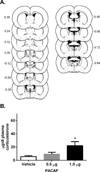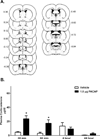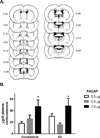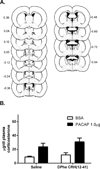Pituitary adenylate cyclase-activating polypeptide (PACAP) in the bed nucleus of the stria terminalis (BNST) increases corticosterone in male and female rats
- PMID: 24845172
- PMCID: PMC4050443
- DOI: 10.1016/j.psyneuen.2014.03.007
Pituitary adenylate cyclase-activating polypeptide (PACAP) in the bed nucleus of the stria terminalis (BNST) increases corticosterone in male and female rats
Abstract
Single nucleotide polymorphisms (SNP) in the genes for pituitary adenylate cyclase-activating polypeptide (PACAP) and the PAC1 receptor have been associated with several psychiatric disorders whose etiology has been associated with stressor exposure and/or dysregulation of the hypothalamic-pituitary-adrenal (HPA) axis. In rats, exposure to repeated variate stress has been shown to increase PACAP and its cognate PAC1 receptor expression in the bed nucleus of the stria terminalis (BNST), a brain region implicated in anxiety and depression-related behaviors as well as the regulation of HPA axis activity. We have argued that changes in BNST PACAP signaling may mediate the changes in emotional behavior and dysregulation of the HPA axis associated with anxiety and mood disorders. The current set of studies was designed to determine whether BNST PACAP infusion leads to activation of the HPA axis as determined by increases in plasma corticosterone. We observed an increase in plasma corticosterone levels 30min following BNST PACAP38 infusion in male and female rats, which was independent of estradiol (E2) treatment in females, and we found that plasma corticosterone levels were increased at both 30min and 60min, but returned to baseline levels 4h following the highest dose. PACAP38 infusion into the lateral ventricles immediately above the BNST did not alter plasma corticosterone level, and the increased plasma corticosterone following BNST PACAP was not blocked by BNST corticotropin releasing hormone (CRH) receptor antagonism. These results support others suggesting that BNST PACAP plays a key role in regulating stress responses.
Keywords: Anxiety; Corticotropin-releasing factor; Corticotropin-releasing hormone; Cortisol; Estradiol; Estrogen; Extended amygdala; Glucocorticoids; HPA axis; Stress.
Copyright © 2014 Elsevier Ltd. All rights reserved.
Conflict of interest statement
Dr. Lezak declares no conflict of interest.
Ms. Roelke declares no conflict of interest.
Ms. Harris declares no conflict of interest.
Ms. Choi declares no conflict of interest.
Mr. Edwards declares no conflict of interest.
Mr. Gick declares no conflict of interest.
Ms. Cocchiaro declares no conflict of interest.
Mr. Missig declares no conflict of interest.
Dr. Roman declares no conflict of interest.
Dr. Braas declares no conflict of interest.
Dr. Toufexis declares no conflict of interest.
Dr. May declares no conflict of interest.
Dr. Hammack declares no conflict of interest.
Figures




Similar articles
-
PAC1 receptor antagonism in the bed nucleus of the stria terminalis (BNST) attenuates the endocrine and behavioral consequences of chronic stress.Psychoneuroendocrinology. 2014 Sep;47:151-65. doi: 10.1016/j.psyneuen.2014.05.014. Epub 2014 May 27. Psychoneuroendocrinology. 2014. PMID: 25001965 Free PMC article.
-
The Effects of Prior Stress on Anxiety-Like Responding to Intra-BNST Pituitary Adenylate Cyclase Activating Polypeptide in Male and Female Rats.Neuropsychopharmacology. 2017 Jul;42(8):1679-1687. doi: 10.1038/npp.2017.16. Epub 2017 Jan 20. Neuropsychopharmacology. 2017. PMID: 28106040 Free PMC article.
-
Regulation of bed nucleus of the stria terminalis PACAP expression by stress and corticosterone.J Mol Neurosci. 2014 Nov;54(3):477-84. doi: 10.1007/s12031-014-0269-8. Epub 2014 Mar 12. J Mol Neurosci. 2014. PMID: 24614974 Free PMC article.
-
Roles for pituitary adenylate cyclase-activating peptide (PACAP) expression and signaling in the bed nucleus of the stria terminalis (BNST) in mediating the behavioral consequences of chronic stress.J Mol Neurosci. 2010 Nov;42(3):327-40. doi: 10.1007/s12031-010-9364-7. Epub 2010 Apr 20. J Mol Neurosci. 2010. PMID: 20405238 Free PMC article. Review.
-
Pituitary Adenylate Cyclase-Activating Peptide (PACAP) Signaling and the Dark Side of Addiction.J Mol Neurosci. 2019 Jul;68(3):453-464. doi: 10.1007/s12031-018-1147-6. Epub 2018 Aug 3. J Mol Neurosci. 2019. PMID: 30074172 Free PMC article. Review.
Cited by
-
Circulating PACAP peptide and PAC1R genotype as possible transdiagnostic biomarkers for anxiety disorders in women: a preliminary study.Neuropsychopharmacology. 2020 Jun;45(7):1125-1133. doi: 10.1038/s41386-020-0604-4. Epub 2020 Jan 7. Neuropsychopharmacology. 2020. PMID: 31910434 Free PMC article.
-
Chronic stress induces cell type-selective transcriptomic and electrophysiological changes in the bed nucleus of the stria terminalis.Neuropharmacology. 2019 May 15;150:80-90. doi: 10.1016/j.neuropharm.2019.03.013. Epub 2019 Mar 14. Neuropharmacology. 2019. PMID: 30878403 Free PMC article.
-
PAC1 receptor antagonism in the bed nucleus of the stria terminalis (BNST) attenuates the endocrine and behavioral consequences of chronic stress.Psychoneuroendocrinology. 2014 Sep;47:151-65. doi: 10.1016/j.psyneuen.2014.05.014. Epub 2014 May 27. Psychoneuroendocrinology. 2014. PMID: 25001965 Free PMC article.
-
Adolescent anxiety disorders and the developing brain: comparing neuroimaging findings in adolescents and adults.Gen Psychiatr. 2021 Aug 4;34(4):e100411. doi: 10.1136/gpsych-2020-100411. eCollection 2021. Gen Psychiatr. 2021. PMID: 34423252 Free PMC article. Review.
-
PACAP regulates neuroendocrine and behavioral stress responses via CRF-containing neurons of the rat hypothalamic paraventricular nucleus.Neuropsychopharmacology. 2025 Feb;50(3):519-530. doi: 10.1038/s41386-024-02016-9. Epub 2024 Oct 29. Neuropsychopharmacology. 2025. PMID: 39472527 Free PMC article.
References
-
- Agarwal A, Halvorson LM, Legradi G. Pituitary adenylate cyclase-activating polypeptide (PACAP) mimics neuroendocrine and behavioral manifestations of stress: Evidence for PKA-mediated expression of the corticotropin-releasing hormone (CRH) gene. Brain Research. Molecular Brain Research. 2005;138:45–57. - PMC - PubMed
-
- Almli LM, Mercer KB, Kerley K, Feng H, Bradley B, Conneely KN, Ressler KJ. ADCYAP1R1 genotype associates with post-traumatic stress symptoms in highly traumatized African-American females. American journal of medical genetics. Part B, Neuropsychiatric genetics : the official publication of the International Society of Psychiatric Genetics. 2013;162B:262–272. - PMC - PubMed
Publication types
MeSH terms
Substances
Grants and funding
LinkOut - more resources
Full Text Sources
Other Literature Sources

